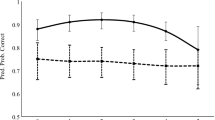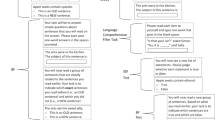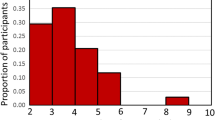Abstract
Encoding tasks that increase memory accuracy are appealing from both practical and theoretical perspectives. Within the Deese/Roediger-McDermott (DRM) paradigm, we found that generating list words from anagrams (relative to reading) produced a mirror effect: enhanced recognition of studied words coupled with a reduction in false recognition. Signal detection analyses suggest that the increase in correct recognition was due to enhanced item-specific encoding of the list words, whereas the reduction in false recognition was due to enhanced strategic monitoring at test (i.e., a distinctiveness heuristic), rather than to reduced relational encoding at study. Further support for a distinctiveness heuristic account was obtained using both “theme judgment” instructions and within-group conditions. In our final experiment, we replicated this mirror effect using a purely mnemonic (self-referential) encoding task, showing that extra perceptual cues are not necessary to induce participants to adopt a successful memory-improvement strategy at test.
Similar content being viewed by others
References
Arndt, J., &Reder, L. (2003). The effect of distinctive visual information on false recognition.Journal of Memory & Language,48, 1–15.
Banks, W. P. (1970). Signal detection theory and human memory.Psychological Bulletin,74, 81–99.
Begg, I. (1978). Similarity and contrast in memory for relations.Memory & Cognition,6, 509–517.
Benjamin, A. S. (2001). On the dual effects of repetition on false recognition.Journal of Experimental Psychology: Learning, Memory, & Cognition,27, 941–947.
Bernstein, D. M., Whittlesea, B. W. A., &Loftus, E. F. (2002). Increasing confidence in remote autobiographical memory and general knowledge: Extensions of the revelation effect.Memory & Cognition,30, 432–438.
Bruce, D., &Winograd, E. (1998). Remembering Deese: The zeitgeist, the sociology of science, and false memories.Psychonomic Bulletin & Review,5, 615–624.
Cary, M., &Reder, L. M. (2003). A dual-process account of the liststrength and strength-based mirror effects in recognition.Journal of Memory & Language,49, 231–248.
Deese, J. (1959). On the prediction of occurrence of particular verbal intrusions in immediate recall.Journal of Experimental Psychology,58, 17–22.
deWinstanley, P. A., Bjork, E. L., &Bjork, R. A. (1996). Generation effects and the lack thereof: The role of transfer-appropriate processing.Memory,4, 31–48.
Dobbins, I. G. &Kroll, N. E. A. (2005). Distinctiveness and the recognition mirror effect: Evidence for an item-based criterion placement heuristic.Journal of Experimental Psychology: Learning, Memory, & Cognition,31, 1186–1198.
Dodson, C. S. &Hege, A. C. G. (2005). Speeded retrieval abolishes the false memory suppression effect: Evidence for the distinctiveness heuristic.Psychonomic Bulletin & Review,12, 726–731.
Dodson, C. S. Schacter, D. L. (2001). “If I had said it I would have remembered it”: Reducing false memories with a distinctiveness heuristic.Psychonomic Bulletin & Review,8, 155–161.
Dodson, C. S., &Schacter, D. L. (2002). When false recognition meets metacognition: The distinctiveness heuristic.Journal of Memory & Language,46, 782–803.
Ebbinghaus, H. (1885/1964).Memory: A contribution to experimental psychology (H. A. Ruger & C. E. Bussenius, Trans.), New York: Dover Publications.
Gallo, D. A., Roediger, H. L., III,&McDermott, K. B. (2001). Associative false recognition occurs without strategic criterion shifts.Psychonomic Bulletin & Review,8, 579–586.
Gallo, D. A., Weiss, J. A., &Schacter, D. L. (2004). Monitoring false recognition with criterial recollection tests: Distinctiveness heuristic versus criterion shifts.Journal of Memory & Language,51, 473–493.
Gardiner, J. M., &Hampton, J. A. (1985). Semantic memory and the generation effect: Some tests of the lexical activation hypothesis.Journal of Experimental Psychology: Learning, Memory, & Cognition,11, 732–741.
Glanzer, M., &Adams, J. K. (1990). The mirror effect in recognition memory: Data and theory.Journal of Experimental Psychology: Learning, Memory, & Cognition,16, 5–16.
Greene, R. L. (1992).Human memory: Paradigms and paradoxes. Hillsdale, NJ: Erlbaum.
Gunter, R. W., Ivanko, S. L., &Bodner, G. E. (2005). Can test list context manipulations improve recognition accuracy in the DRM paradigm?Memory,33, 862–873.
Hege, A. C. G., &Dodson, C. S. (2004). Why distinctive information reduces false memories: Evidence for both impoverished relationalencoding and distinctiveness heuristic accounts.Journal of Experimental Psychology: Learning, Memory, & Cognition,30, 787–795.
Hicks, J. L., &Marsh, R. L. (1999). Attempts to reduce the incidence of false recall with source monitoring.Journal of Experimental Psychology: Learning, Memory, & Cognition,25, 1195–1209.
Hicks, J. L., &Marsh, R. L. (2001). False recognition occurs more frequently during source identification than during old-new recognition.Journal of Experimental Psychology: Learning, Memory, & Cognition,27, 375–383.
Hyman, I. E., Husband, T. H., &Billings, F. J. (1995). False memories of childhood experiences.Applied Cognitive Psychology,9, 181–197.
Israel, L., &Schacter, D. L. (1997). Pictorial encoding reduces false recognition of semantic associates.Psychonomic Bulletin & Review,4, 577–581.
Johansson, M., &Sternberg, G. (2002). Inducing and reducing false memories: A Swedish version of the Deese-Roediger-McDermott paradigm.Scandinavian Journal of Psychology,43, 369–383.
Kinoshita, S. (1989). Generation enhances semantic processing? The role of distinctiveness in the generation effect.Memory & Cognition,17, 563–571.
Koutstaal, W., &Schacter, D. L. (1997). Gist-based false recognition of pictures in older and younger adults.Journal of Memory & Language,37, 555–583.
Lindsay, D. S., &Read, J. D. (1994). Psychotherapy and memories of childhood sexual abuse: A cognitive perspective.Applied Cognitive Psychology,8, 281–338.
Loftus, E. F., Miller, D. G., &Burns, H. J. (1978). Semantic integration of verbal information into a visual memory.Journal of Experimental Psychology: Human Learning & Memory,4, 19–31.
Macmillan, N. A., &Creelman, C. D. (1991).Detection theory: A user’s guide. New York: Cambridge University Press.
McCabe, D. P., Presmanes, A. G., Robertson, C. L., &Smith, A. D. (2004). Item-specific processing reduces false memories.Psychonomic Bulletin & Review,11, 1074–1079.
McCabe, D. P., &Smith, A. D. (2006). The distinctiveness heuristic in false recognition and false recall.Memory,14, 570–583.
McDaniel, M. A., Wadill, P. J., &Einstein, G. O. (1988). A contextual account of the generation effect: A three-factor theory.Journal of Memory & Language,27, 521–536.
McDermott, K. B. (1996). The persistence of false memories in list recall.Journal of Memory & Language,35, 212–230.
McDermott, K. B., &Roediger, H. L., III (1998). Attempting to avoid illusory memories: Robust false recognition of associates persist under conditions of explicit warnings and immediate testing.Journal of Memory & Language,39, 508–520.
Mintzer, M. Z., &Snodgrass, J. G. (1999). The picture superiority effect: Support for the distinctiveness model.American Journal of Psychology,112, 113–146.
Mulligan, N. W. (2001). Generation and hypermnesia.Journal of Experimental Psychology: Learning, Memory, & Cognition,13, 436–450.
Pierce, B. H., Gallo, D. A., Weiss, J. A., &Schacter, D. L. (2005). The modality effect in false recognition: Evidence for test-based monitoring.Memory & Cognition,33, 1407–1413.
Rao, K. V., &Proctor, R. W. (1984). Study-phase processing and the word frequency effect in recognition memory.Journal of Experimental Psychology: Learning, Memory, & Cognition,10, 386–394.
Rhodes, M. G., &Anastasi, J. S. (2000). The effects of a levels-of-processing manipulation on false recall.Psychonomic Bulletin & Review,7, 158–162.
Roediger, H. L., III,&McDermott, K. B. (1995). Creating false memories: Remembering words not presented in lists.Journal of Experimental Psychology: Learning, Memory, & Cognition,21, 803–814.
Rogers, T. B. (1977). Self-reference in memory: Recognition of personality items.Journal of Research in Personality,11, 295–305.
Rogers, T. B., Kuiper, N. A., &Kirker, W. S. (1977). Self-reference and the encoding of personal information.Journal of Personality & Social Psychology,35, 677–688.
Schacter, D. L., Cendan, D. L., Dodson, C. S., &Clifford, E. R. (2001). Retrieval conditions and false recognition: Testing the distinctiveness heuristic.Psychonomic Bulletin & Review,8, 827–833.
Schacter, D. L., Israel, L., &Racine, C. (1999). Suppressing false recognition in younger and older adults: The distinctiveness heuristic.Journal of Memory & Language,40, 1–24.
Seamon, J. G., Goodkind, M. S., Dumey, A. D., Dick, E., Aufseeser, M. S., Strickland, S. E., Woulfin, J. R., &Fung, N. S. (2003). “If I didn’t write it, why would I remember it?”: Effects of encoding, attention, and practice on accurate and false memory.Memory & Cognition,31, 445–457.
Seamon, J. G., Luo, C. R., Schwartz, M. A., Jones, K. J., Lee, D. M., &Jones, S. J. (2002b). Repetition can have similar or different effects on accurate and false recognition.Journal of Memory & Language,46, 323–340.
Slamecka, N. J., &Graf, P. (1978). The generation effect: Delineation of a phenomenon.Journal of Experimental Psychology: Human Learning & Memory,4, 592–604.
Snodgrass, J. G., &Corwin, J. (1988). Pragmatics of measuring recognition memory: Applications to dementia and amnesia.Journal of Experimental Psychology: General,117, 34–50.
Soraci, S. A., Carlin, M. T., Toglia, M. P., Chechile, R. A., &Neuschatz, J. S. (2003). Generative processing and false memories: When there is no cost.Journal of Experimental Psychology: Learning, Memory, & Cognition,29, 511–523.
Stadler, M. A., Roediger, H. L., III,&McDermott, K. B. (1999). Norms for word lists that create false memories.Memory & Cognition,27, 494–500.
Stretch, V., &Wixted, J. T. (1998). On the difference between strength-based and frequency-based mirror effects in recognition memory.Journal of Experimental Psychology: Learning, Memory, & Cognition,18, 681–690
Thapar, A., &McDermott, K. B. (2001). False recall and false recognition induced by presentation of associated words: Effects of retention interval and level of processing.Memory & Cognition,29, 424–432.
Toglia, M. P., Neuschatz, J. S., &Goodwin, K. A. (1999). Recall accuracy and illusory memories: When more is less.Memory,7, 233–256.
Underwood, B. J. (1965). False recognition produced by implicit verbal responses.Journal of Experimental Psychology,70, 122–129.
Wickens, T. D. (2002).Elementary signal detection theory. Oxford: Oxford University Press.
Author information
Authors and Affiliations
Corresponding author
Additional information
The Natural Sciences and Engineering Research Council of Canada supported this research through a postgraduate scholarship to R.W.G. and a research grant to G.E.B.
Rights and permissions
About this article
Cite this article
Gunter, R.W., Bodner, G.E. & Azad, T. Generation and mnemonic encoding induce a mirror effect in the DRM paradigm. Memory & Cognition 35, 1083–1092 (2007). https://doi.org/10.3758/BF03193480
Received:
Accepted:
Published:
Issue Date:
DOI: https://doi.org/10.3758/BF03193480




